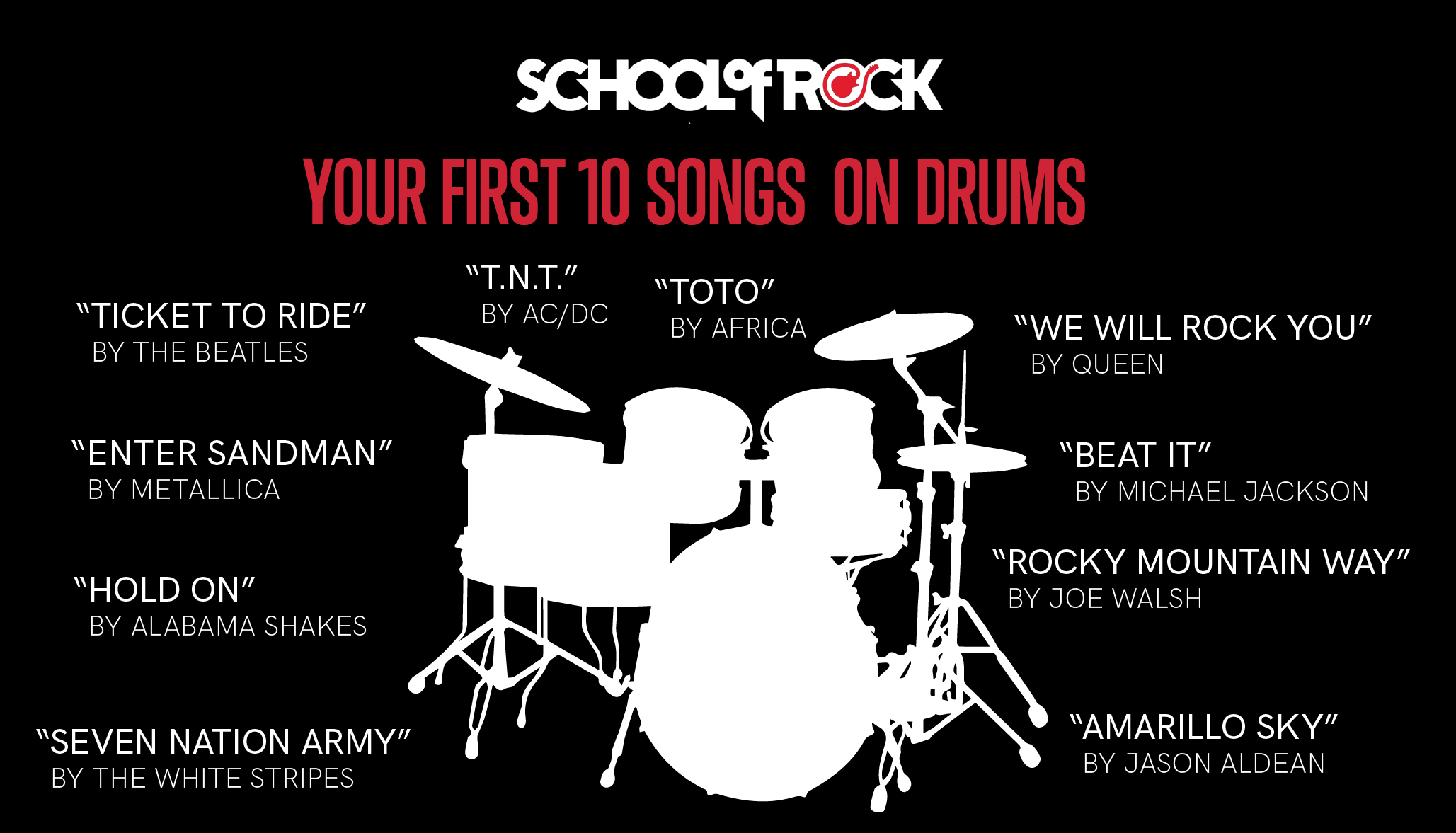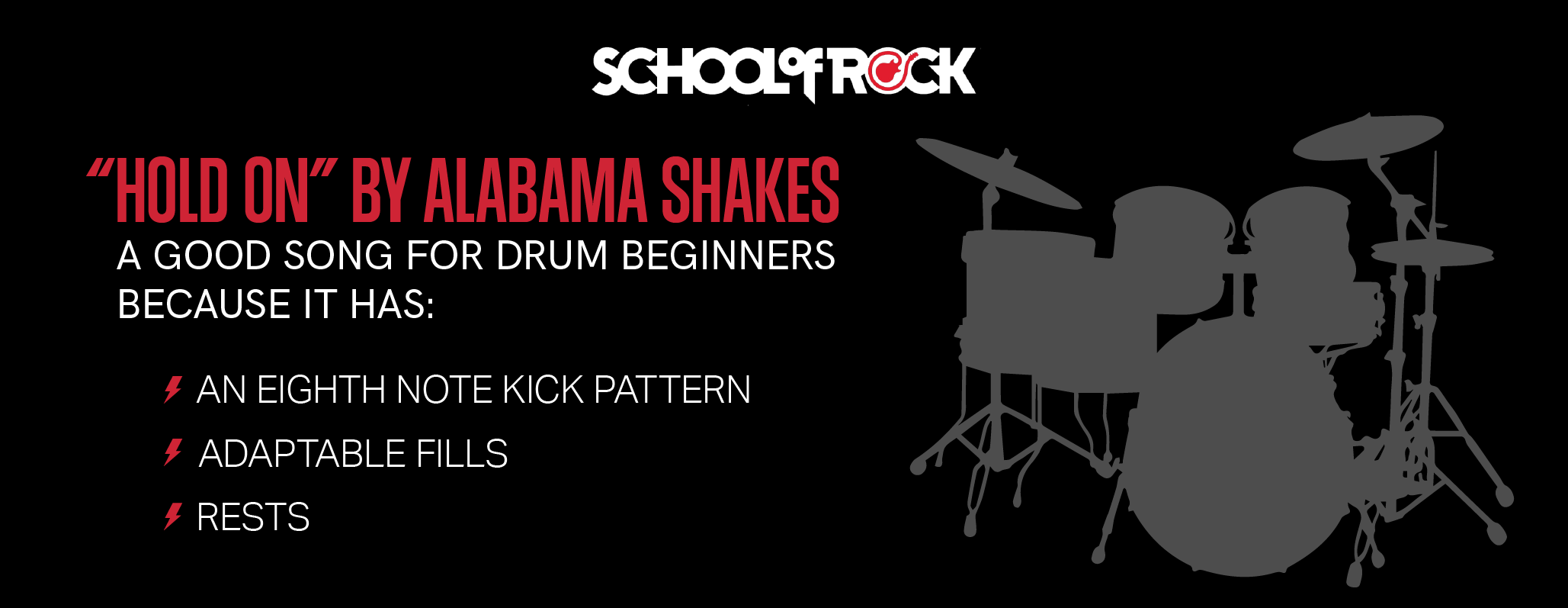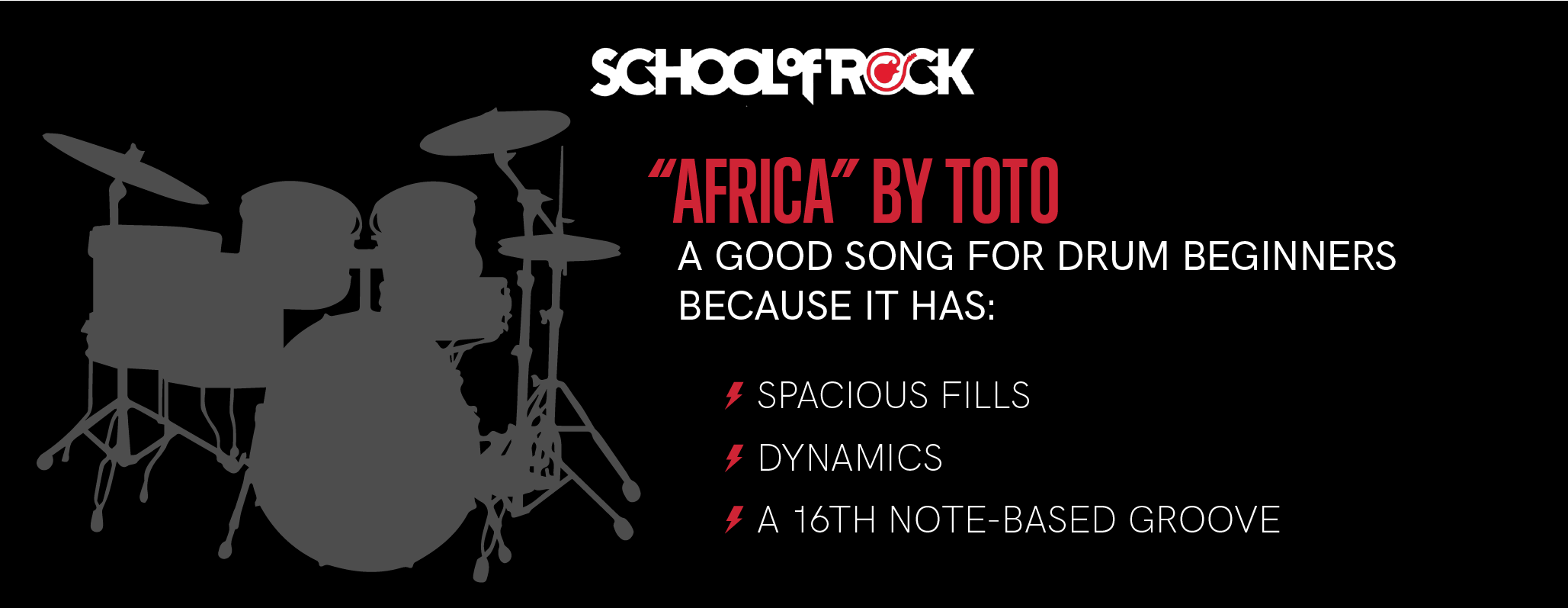Congratulations! You absolutely chose the right instrument to learn when you picked the drums! The drum is one of the oldest instruments and has been one of the most important throughout human history. From being used as a form of communication both in peacetime and in war, to the concert hall giving a pulse and adding color to the symphonic epics of Beethoven, Wagner, and Holst, to being the backbone of rock, country, jazz, Latin, pop, R&B, and an endless list of other styles; the drums have certainly seen a lot over the years.
The drums are the easiest instrument to learn, but the hardest to master, but after you learn a few basic patterns and grooves you can pretty much hang in on any song you choose! Drum parts can be simplified to a point where anyone can play them. As you grow as a player, you can go beyond playing simplified parts until eventually, you’re playing in perfect unison with your drumming heroes.
There are so many options to choose from when it comes to picking your first song. In addition to this resource, a good teacher will be instrumental (pun intended) in helping you choose the right song to start with. I have selected 10 easy drum songs from different genres and eras that will get you started on the path toward long-term drumming success!

1. “We Will Rock You” by Queen, with drummer Roger Taylor
Starting with one of the best drum songs ever, “We Will Rock You” by Queen is one of those songs that everyone will not only be singing along to but will be drumming along to as well! Despite being on this list of drum songs for beginners, there are no drums on this track. The “percussion” utilizes stomping and clapping to create the legendary “boom, boom, schmack” that everyone knows. This song instantly makes me think of being at a sporting event, particularly a baseball game when the home team is about to come to bat!
“We Will Rock You” has a simple rhythm that pretty much anyone can learn. Musically speaking, it has several elements that are great to begin developing on day 1, making it appropriate for any age.
Simple Repeating Rhythms
- The groove is made up of eighth notes and quarter notes! This is perfect for practicing maintaining a steady groove over a long period of time without speeding up or slowing down.
Flams
- The song heavily relies on flams played on beats 2 & 4 otherwise known as the “backbeat”. A flam is two notes played very close together, usually on a single drum. It is one of the 3 most basic rudiments!
Toms!
- One of the rare easy drum songs that features the toms as one of the main elements of the groove. Usually, the toms are used for effect within a drum fill. Not in "We Will Rock You"! The toms are a mainstay in this tune and are essential to getting those thunderous “boom, boom” sounds before the “schmack” of the snare.
Even though there are no real drums on the recording, the “boom, boom, schmack” can easily be recreated on the kit. The stomps can easily be replaced by the toms, the kick drum, or both. The claps become a flam on the snare drum on beats 2 and 4. The challenge for the student is to recreate non-drum-originated sounds on the kit. This will give both new and veteran rock drummers something to work towards! Roger Taylor does an excellent job in bringing this a capella part to life during a live performance of the song, check out the video below.
2. “Seven Nation Army” by The White Stripes with drummer Meg White
“Seven Nation Army” is another song that instantly brings the energy up in the room. The White Stripes were a rock duo (yes, a duo) that was active from 1997 until 2011. A simple song form with repeating sections makes it easy to make a song map while you’re learning it. This is a song that you can absolutely “go ham” on while still working to maintain a steady groove and tempo. In addition to that, several other elements make this tune an absolute must-learn for beginners!
Dynamics
- Something that makes music different from simply being pleasant-sounding noise is variations in volume. We call this attribute “dynamics.” “Seven Nation Army” utilizes dynamics to create contrast between the verses and the choruses. Here’s a pro tip for making your dynamics stand out: make sure your quiet parts are really quiet, even quieter than you think they need to be. Doing this will make the loud parts seem even louder!
Ensemble Unison Playing
- One of the highlights—and harder parts—for newer students is the ensemble unison during the chorus. The feel switches briefly from straight-ahead quarter notes to quarter-note triplets and back to quarter notes. That might sound complicated but the silver lining is that the whole band plays that rhythm together, making learning the part by ear a breeze!
Hi-Hat Splashing
- A rare song and easy drum song that features left-foot hi-hat work. The pounding quarter notes on the kick and floor tom are accompanied by light hi-hat splashes. This is achieved by depressing the hi-hat pedal until the cymbals collide, then immediately releasing it to allow the cymbals to ring. The effect is similar to lightly tapping a pair of orchestral crash cymbals together.
Quarter notes are one of the easier rhythms to learn as they are counted using only numbers. If you can count to four over and over again (1, 2, 3, 4, 1, 2, 3, 4, etc.) you can count quarter notes! One of the challenges for this song would be ensuring that there is equal spacing between each note; not playing too soon or too late. Doing this will make the quarter note triplets have the proper effect in context!
3. “Hold On” by Alabama Shakes, with drummer Steve Johnson
The band Alabama Shakes was a more recently active band, forming in 2009 and staying together until 2018. Their unique sound that blends both modern and old school will certainly attract most students. This is another song with a relatively simple structure that’s easy to follow and learn. The song has a very chill feel that amps up when the chorus starts. It rollercoasters between high and low energy with enough variety to keep students interested.

Eighth Note Kick Pattern
- This song features a repeating kick drum pattern starting on the “&” count and then finishing on the odd beats (beat 1 and beat 3). When patterns start on an upbeat note it gives the sense of the music being propelled forward, a compositional technique that can add so much to the song.
Adaptable fills
- The true drum fills in this song are sometimes pretty fast and complicated for a beginner drummer. Fortunately, however, the fills are very easy to simplify so that they are playable at any skill level. As you grow as a musician, increase the complexity of the fills accordingly!
Rests
- One of the best parts of the song in my opinion is the short breaks in the music during the chorus. Breaks in music are called rests. Every note value (whole, half, quarter, eighth, etc.) has a corresponding rest. If there can be noise for a length of time there can also be silence for that same length of time. Clever usage of rests within a part (sometimes called syncopation) breaks up the monotony of what could otherwise be called boring parts.
Getting the rest in the right spot during the fills will be the biggest challenge for a new drum student. This is an easy drum song to practice counting and playing at the same time. Doing so will help the student become more aware of where they are in the music and how their parts fit into the musical puzzle.
4. “Come Together” by the Beatles, with drummer Ringo Starr
If there are any music fans out there, I’m sure you knew it was only a matter of time before this man made an appearance on this list! Ringo Starr is perhaps one of, if not the most important rock drummer ever. While not the most technically gifted drummer (you won’t find him playing Dream Theater) his feel, style, and ability to create the perfect part is unmatched. “Come Together” is a perfect example of this.
Left-Hand Lead
- His opening fill goes from right to left as they start on the floor tom leading with his left hand as Ringo was left-handed but played a right-handed kit. This is challenging for a beginning drummer, so most play it with a right-hand lead going from the rack to the floor tom.
“Riding the Floor tom”
- For the verses Ringo just played the floor tom and the kick creating a solid “four on the floor” style beat in 4/4 time. He played a typical ride cymbal pattern on the floor tom to make the beat more driving and powerful.
The biggest challenge of this song is recreating the iconic feel of Ringo Starr. Ringo’s style is said to be "often attempted, but never imitated." The truth is the only person that sounds like Ringo is, Ringo. But, that shouldn’t stop you from trying! The song’s slow tempo is perfect for beginners and is great practice for counting ¼ notes and ⅛ grooves.
5. “Rocky Mountain Way” by Joe Walsh, with drummer Joe Vitale
“Rocky Mountain Way” is the bluesiest song on the list so far. It’s also the first song on the list to be in a triple meter. The 1, 2, 3, 4, 5, 6, feel of this song is not unique. It is likely the second most common feel after 1, 2, 3, 4. Joe Walsh perfectly marries the blues and rock in this tune. The skills developed in this song can be carried onward and will most definitely be used again in your playing career.
Triplet Feel
- There are two main feels in music. Duple (even) and Triple (odd). Many describe duple as being square, like a march. Triple has a bit of a sway to it, almost like you’re dancing. To learn the triplet feel, start by counting to three over and over again just as you would count to four. Emphasize each beat 1.
Shuffle Groove
- Parts of this song feature what’s known as a shuffle groove. Albeit, a slow one, a shuffle groove is created by taking a three-note pattern and resting on the second note. Start by clapping your hands while counting to three. Now remove the second note (only clapping on beat 1 and beat 3). What you have now is a shuffle pattern!
Triplet-based Fills
- Being that the song is in a triple meter, the fills are also going to be based on triplets. The fills are fairly simple in this song so it will greatly help in learning to play with a triplet feel.
6/8 and 12/8 are the most common triple meters in popular music. Though you could count from 1 to 12 over and over again, a macro feel is usually imposed over this. While 12/8 has 12 eighth notes in each measure, the feel is almost always broken down into four groups of 3. A way you can practice this is to count: “one, two, three, two, two, three, three, two, three, four, two, three” with the bold counts representing each beat. It’ll put the triple meter into more easily understood terms should you have only played easy drum songs for beginners songs in 4/4 to this point. Songs whose time signatures have an 8 as the bottom number and have a multiple of 3 on the top are felt in triplet time. In double time, groups of 2 get the beat, while in triple time, groups of three get the beat.
6. “T.N.T.” by AC/DC, with drummer Phil Rudd
We now come to the king of “K.I.S.S.” style (Keep It Simple, Silly) drumming. Phil Rudd from AC/DC made his name by being one of the greatest rock drummers to ever lay down and maintain a rock-solid groove. His bread and butter are eighth-note hi-hat grooves with the snare on beat 2 and beat 4. No one will ever accuse Phil Rudd of overplaying. Very few can match the accuracy and consistency of Rudd’s drumming. This song is another big hit with students and they can sing along to the chorus while playing. It’s also another high-energy song that will keep them occupied. There are several pieces of this tune, however, that make this one worth learning.
Floor Tom Grooves
- This song features an entire verse where the eighth note right-hand part is played on the floor tom. Rudd makes this groove blend perfectly with the music around him without making it rumble and thunder to the point where it is overbearing.
Meter Changes
- The majority of the song is in 4/4. However, the last measure of each chorus is 2 basic drum beats shorter than the other measures in that section. The line “Watch me explode,” is a measure of 2/4. The following measure returns 4/4. The effect this has is a form of word painting. When things explode they cease to exist. This is represented by ending the measure two beats early.
Crash Over the Barline
- This song does something unusual with its transitions. Each section ends with a crash on the “&” of beat 4. This hit sustains over the bar line into the next measure. The effect this creates is suspense. By having the emphasis on the “&” count we know that the music will feel propelled forward. By following that up with a long period of silence, the listener is left in limbo between sections before the chorus finally kicks in.
With so many different sections and different parts to go with each, “T.N.T.” challenges the player with memorizing and later recalling which sections are which. This is a great and important skill to develop as a budding drummer.
7. “Bad Moon Rising” by Creedence Clearwater Revival, with drummer Doug Clifford
“Bad Moon Rising” is one of the best beginner drumming songs for beginning drummers as it’s based on a very simple beat with just two minor changes in the syncopation of the kick drum. While CCR was a rock ‘n’ roll band, they had influences from country, folk, and blues. This tune has a distinct country feel.
Who Needs Cymbals?
- Aside from the final note, there are no crash-or-ride cymbals in this song. Just a relentless kick/snare/hi-hat pattern. It takes a great deal of restraint to maintain a simple beat without adding embellishment.
Triplet Kick Variations
- There are two spots in the song where Doug changed up the kick patterns. In the verse, he adds a beat to the kick on the and of 1 whereas in the chorus he adds it on the 'and' of 3. In each case, he creates a triplet to give the beat some swing.
The challenge of playing country and roots music whether you’re brand new or have been playing for 20 years is being disciplined enough to stay out of the way of the vocals and other instruments. As a drummer, you’re essentially just there for effects and big moments. Understanding that role is important for long-term success in many styles of music.
8. “Africa” by Toto, with drummer Jeff Porcaro
Jeff Porcaro was one of the best rock drummers ever. He laid down the drum tracks on many well-known songs throughout his career. His parts, like Ringo’s, always seem to be “just right” for the song. That being said, this is not his only appearance on this list! He is perhaps most well-known for his work with the band Toto. While his magnum opus would most likely be considered to be the song “Rosanna,” his drumming on “Africa” is some of the most tasteful playing you’ll ever hear.

Spacious Fills
- One of the most iconic portions of “Africa” is the big tom fills signaling the chorus to enter. These fills are spread across the sixteenth note grid (counting out 1-e-&-a) with large gaps in between some of the notes. Counting out loud and practicing slowly will make these syncopated parts easy to conquer.
Dynamics
- Jeff Porcaro was not just a drummer, he was a musician in the truest sense of the word. His touch was always perfect, whether the part was extremely complicated or extremely simple. The key to playing “Africa” correctly is to adhere to the dynamics of the tune. The verses should be played with a far lighter touch than the choruses. Neither section, though, calls for bashing. That can be reserved for the iconic fills!
16th Note-based Groove
- Likely until now, you have only experienced easy songs to play on drums with eighth note-based grooves. This means the right hand provided eighth notes on one of the instruments while the left hand and right foot handled kick and snare duties. This song features a sixteenth-note-based groove. Sixteenth notes are twice as fast as eighth notes. Depending on where you are as a player, playing these notes with one hand might not be possible yet. In that case, using two hands to play the groove is perfectly acceptable! You will essentially be playing a single-stroke roll on the hi-hat with beat 2 and beat 4 having your right hand move to the snare drum.
The real challenge of this song is getting the touch right. As far as beginner drum songs go, none of the parts are too difficult (save for the one-handed sixteenth notes) so they’ll be able to learn it with ease, especially with the guidance of a teacher. Because of this, they can quickly move on to developing their musicianship, focusing on not only how loud or soft they are playing, but how they’re actually striking the drums and cymbals. Beginners can work on playing accurately and with a lighter touch, while my advanced students will strive to imitate a shaker in the hi-hat part.
9. “Enter Sandman” by Metallica, with drummer Lars Ulrich
By far, one of the best drum songs among student drummers is “Enter Sandman.” The drums are so aggressive sounding, which may be what so many students love most about the song—they never feel like they’re hitting too hard!
Upbeat Crashes
- One of the staples, and admittedly hardest parts of this song are the placements of the crashes. In a high-energy, hard-hitting song, it can be difficult to accurately place crash hits on the “&” counts. This is a good opportunity to learn counting and subdividing even when the energy is in the stratosphere. This ultimately lends itself well to learning other Metallica songs as well as other high-energy, aggressive songs from bands like Mötley Crüe.
Rim Shots
- This is a go-to song when learning how to play rimshots on the snare. A rimshot is when the stick strikes both the center of the head and the rim closest to the player at the same time. This causes a much louder, more aggressive sound from the drum.
To Accent or Not To Accent, That is the Question
- It’s important to learn how to play dynamically from very early on, and “accent-tap” exercises are a good way to practice this. It essentially develops the student’s ability to play both loud and soft notes within close proximity of each other. “Enter Sandman” is one of many good drum songs to reinforce those concepts. The tom part features a mixture of accented and unaccented notes, particularly around the backbeats. The soft-LOUD articulation in these parts is an important skill that will serve a student for the entirety of their career.
The upbeat accents tend to be the biggest challenge students have when playing this song. Through patience and audible counting, though, the issues are corrected fairly quickly. “Enter Sandman” is a great learning opportunity for students to figure out how to keep their energy level high but also focus on accuracy.
10. “Beat It” by Michael Jackson, with drummer Jeff Porcaro
We’re capping this list off with an absolute all-star-laden track. “Beat It” features not only Jeff Porcaro on drums again, but also other members of Toto, legendary session musicians like Greg Phillinganes, and also Eddie Van Halen! And let’s not forget the mastermind behind it all, Michael Jackson. After listening to easy drum songs for beginners such as this one and hearing the blending of hard rock and pop, any remaining doubters consistently fall in love with the song. And best of all, there’s a lot to teach in it!
Delayed Kicks
- One of the most iconic parts of this drum part is the lone kick on the “&” of beat 3. As before, the result of the emphasis on an upbeat is the propulsion of the music! Jeff Porcaro uses this idea to take a simple 1 & 3 kick pattern and add some life to it. It’s also the perfect opportunity for students to learn two-bar repeating patterns.
Mimicking
- The middle section and guitar solo feature syncopated rhythms in the guitars and bass. While the hands will remain the same, the kick drum should imitate this rhythm. Some of the kick notes will land with the snare drum so care towards accurate placement will ensure that there is no flamming between instruments.
Rim Knocks
- It’s very, very rare to meet a beginner drummer whose kit is so nice that they have electronic drums augmenting their acoustic drums. That being said, the 808 at the beginning is a perfect opportunity to learn how to properly execute a rim knock. A rim knock is a “trick” that involves the student laying their stick and hand across the snare, then striking the rim, making a high-pitched popping sound.
The tempo or speed of this song tends to be the biggest challenge for beginner students. “Beat It” is around 140 beats per minute (bpm), which is on the faster side. It’s definitely a stretch for some beginners. The trick here, like anything too difficult, is to slow it down to a tempo that is achievable (maybe like 100 bpm), then slowly increase the speed until you reach the true tempo. Make sure you utilize a metronome to stay on time!
Are You Ready to Take Your Drum Skills to the Next Level?
These are just 10 of the hundreds of beginner drum songs we would recommend for a beginner drummer. These songs are absolutely achievable on your own, but nothing compares to working with an experienced teacher. At School of Rock, we have tons of resources and tools that we can use to help you become the drummer you’ve always dreamed of being. There’s not much that a School of Rock teacher can’t help you with! If you’re not already signed up, give your local school a call today to set up your trial lesson!
About The Author:
Mike Avin is the show director and drum teacher at School of Rock Somerville, NJ. He has experience in drums/percussion, keyboard, guitar, bass guitar and harmonica.














